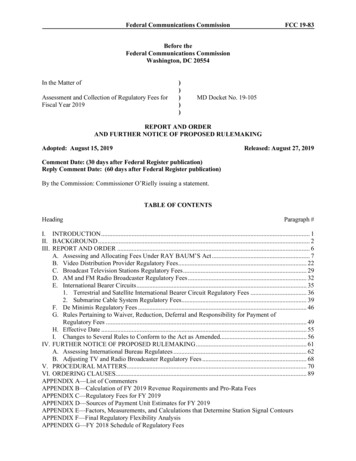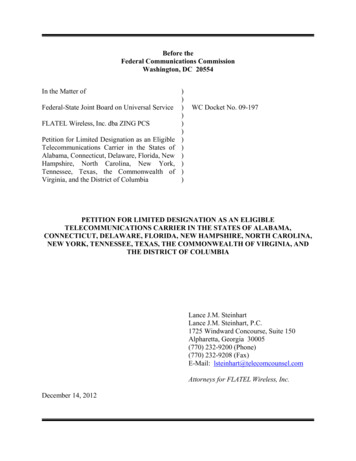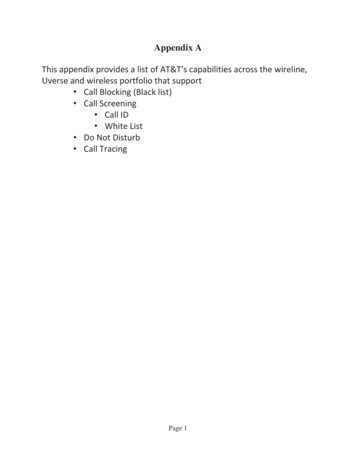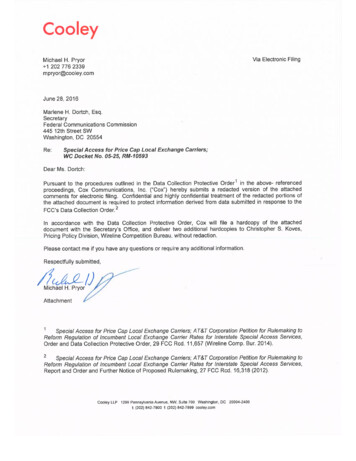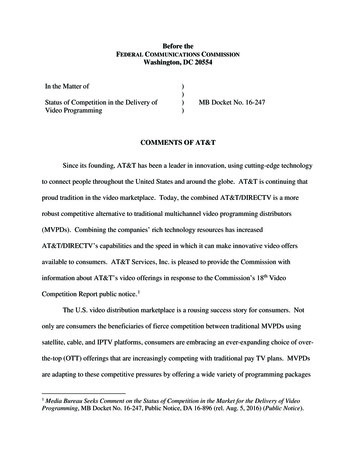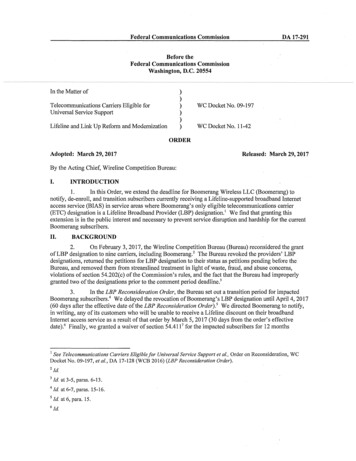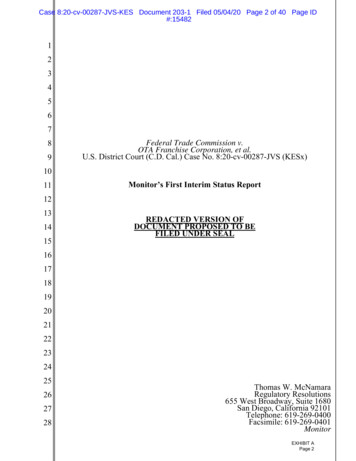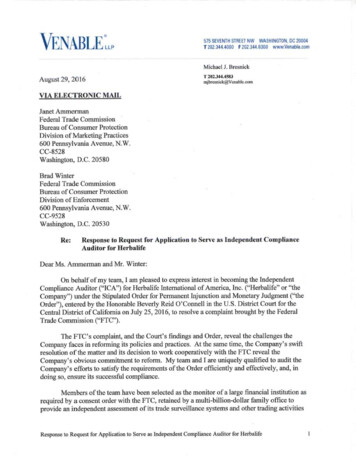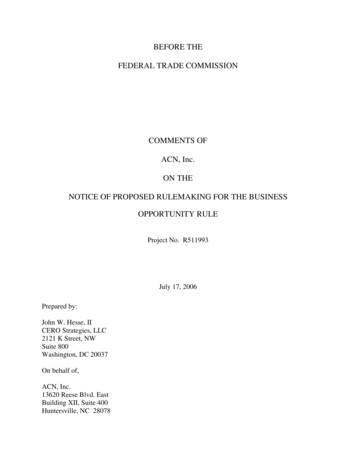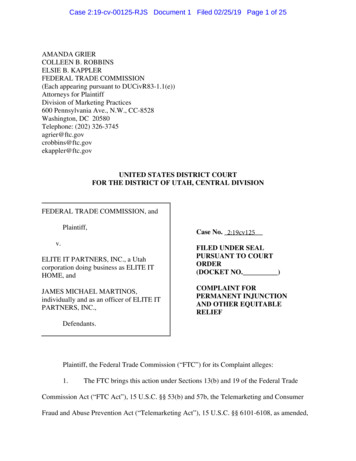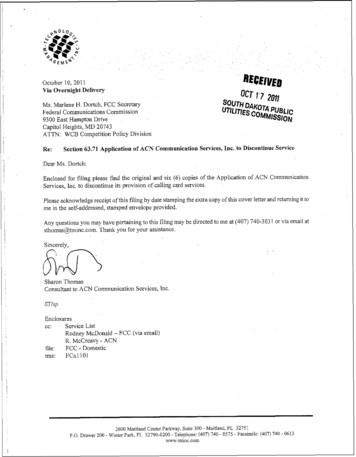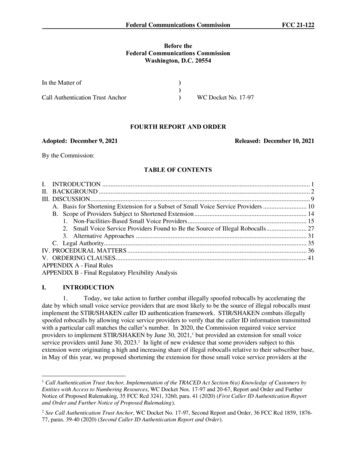
Transcription
Federal Communications CommissionFCC 21-122Before theFederal Communications CommissionWashington, D.C. 20554In the Matter ofCall Authentication Trust Anchor)))WC Docket No. 17-97FOURTH REPORT AND ORDERAdopted: December 9, 2021Released: December 10, 2021By the Commission:TABLE OF CONTENTSI. INTRODUCTION . 1II. BACKGROUND . 2III. DISCUSSION . 9A. Basis for Shortening Extension for a Subset of Small Voice Service Providers . 10B. Scope of Providers Subject to Shortened Extension . 141. Non-Facilities-Based Small Voice Providers . 152. Small Voice Service Providers Found to Be the Source of Illegal Robocalls . 273. Alternative Approaches . 31C. Legal Authority. 35IV. PROCEDURAL MATTERS . 36V. ORDERING CLAUSES. 41APPENDIX A - Final RulesAPPENDIX B - Final Regulatory Flexibility AnalysisI.INTRODUCTION1.Today, we take action to further combat illegally spoofed robocalls by accelerating thedate by which small voice service providers that are most likely to be the source of illegal robocalls mustimplement the STIR/SHAKEN caller ID authentication framework. STIR/SHAKEN combats illegallyspoofed robocalls by allowing voice service providers to verify that the caller ID information transmittedwith a particular call matches the caller’s number. In 2020, the Commission required voice serviceproviders to implement STIR/SHAKEN by June 30, 2021,1 but provided an extension for small voiceservice providers until June 30, 2023.2 In light of new evidence that some providers subject to thisextension were originating a high and increasing share of illegal robocalls relative to their subscriber base,in May of this year, we proposed shortening the extension for those small voice service providers at the1Call Authentication Trust Anchor, Implementation of the TRACED Act Section 6(a) Knowledge of Customers byEntities with Access to Numbering Resources, WC Docket Nos. 17-97 and 20-67, Report and Order and FurtherNotice of Proposed Rulemaking, 35 FCC Rcd 3241, 3260, para. 41 (2020) (First Caller ID Authentication Reportand Order and Further Notice of Proposed Rulemaking).2See Call Authentication Trust Anchor, WC Docket No. 17-97, Second Report and Order, 36 FCC Rcd 1859, 187677, paras. 39-40 (2020) (Second Caller ID Authentication Report and Order).
Federal Communications CommissionFCC 21-122greatest risk of originating illegal robocalls.3 To better protect Americans from illegally spoofed calls, wenow act on this proposal and require non-facilities-based small voice providers to implementSTIR/SHAKEN by June 30, 2022. An extension for an additional year—until June 30, 2023—remainsapplicable to facilities-based small voice providers. We also require small voice service providers of anykind suspected of originating illegal robocalls to implement STIR/SHAKEN on an accelerated timeline.II.BACKGROUND2.The STIR/SHAKEN caller ID authentication framework is a key part of our efforts tocombat illegal robocalls. The framework relies on public-key cryptography to securely transmit theinformation that the originating voice service provider knows about the identity of the caller and itsrelationship to the phone number it is using along with the call, allowing the terminating voice serviceprovider to verify the information on the other end.4 To implement STIR/SHAKEN, a voice serviceprovider must update portions of its network infrastructure to enable it to authenticate and verify caller-IDinformation consistent with the framework.3.In March 2020, the Commission adopted rules requiring voice service providers toimplement STIR/SHAKEN in the Internet Protocol (IP) portions of their voice networks by June 30,2021.5 In accordance with the Pallone-Thune Telephone Robocall Abuse Criminal Enforcement andDeterrence (TRACED) Act, the Commission required voice service providers that use IP technology,including both two-way and one-way interconnected VoIP providers to comply with this mandate.64.The Commission found that widespread implementation of STIR/SHAKEN providesnumerous benefits for voice service providers, their subscribers, and entities involved in enforcement.7The STIR/SHAKEN framework allows an originating voice service provider to share what it knows aboutthe caller ID information transmitted with a call, providing vital information that can be used byterminating voice service providers to block or label illegal robocalls before those calls reach theirsubscribers.8 It also promotes enforcement by appending information about the source of a call into themetadata of the call itself, offering instantaneous traceback without the need to go through the tracebackprocess.9 STIR/SHAKEN implementation further restores trust in caller ID information and makes callrecipients more willing to answer the phone, reduces disruption to E911 networks, reduces providers’compliance response costs, and reduces the government-wide costs of enforcement.10 In total, the3See generally, Call Authentication Trust Anchor, WC Docket No. 17-97, Third Further Notice of ProposedRulemaking, 36 FCC Rcd 8827 (2021) (Small Provider Further Notice).4Second Caller ID Authentication Report and Order, 36 FCC Rcd at 1863, para. 8.547 CFR § 64.6301; First Caller ID Authentication Report and Order and Further Notice of Proposed Rulemaking35 FCC Rcd at 3252, para. 24 (2020).6First Caller ID Authentication Report and Order and Further Notice of Proposed Rulemaking, 35 FCC Rcd at3259, para. 37; Pallone-Thune Telephone Robocall Abuse Criminal Enforcement and Deterrence Act, Pub. L. No.116-105, § 4(a)(2)(B)(ii), 133 Stat. 3274, 3277 (2019) (TRACED Act).7See First Caller ID Authentication Report and Order and Further Notice of Proposed Rulemaking, 35 FCC Rcd at3263-65, paras. 46-52.8See Second Caller ID Authentication Report and Order, 36 FCC Rcd at 1863-64, para. 10.9See id.; see also ATIS & SIP Forum, Errata on ATIS Standard on Signature-based Handling of Assertedinformation using toKENs (SHAKEN), ATIS-1000074-E at § 5.2.4 (2019),https://access.atis.org/apps/group public/download.php/46536/ATIS-1000074-E.zip (describing the originationidentifier).10See First Caller ID Authentication Report and Order and Further Notice of Proposed Rulemaking, 35 FCC Rcd at3263-65, paras. 49-52.2
Federal Communications CommissionFCC 21-122Commission has estimated that the potential monetary benefit from eliminating fraud and nuisance alonewould exceed 13.5 billion per year.115.The TRACED Act created a process by which the Commission could grant an extensionfor a “reasonable period of time” to voice service providers that the Commission determined face “unduehardship” in implementing STIR/SHAKEN.12 After assessing the burdens and barriers faced by differentclasses of voice service providers, the Commission granted the following class-based extensions: (1) atwo-year extension to small voice service providers;13 (2) an extension to voice service providers thatcannot obtain a “certificate” until such provider can obtain one;14 (3) a one-year extension to servicesscheduled for section 214 discontinuance;15 and (4) a continuing extension for the parts of a voice serviceprovider’s network that relies on technology that cannot initiate, maintain, and terminate SIP calls until asolution for such calls is readily available.16 Voice service providers seeking the benefit of theseextensions must implement a robocall mitigation program.17 And like all voice service providers, theymust also respond fully and in a timely manner to traceback requests from certain entities;18 effectivelymitigate illegal traffic when notified by the Commission;19 and adopt affirmative, effective measures toprevent new and renewing customers from using their network to originate illegal calls.206.The Commission defined small voice service providers subject to an extension as thosewith 100,000 or fewer voice service subscriber lines.21 It determined that an extension for small voiceservice providers until June 30, 2023, was appropriate under the TRACED Act because of their highimplementation costs compared to their revenues, the limited STIR/SHAKEN vendor offerings availableto them, the likelihood that costs would decline over time, because an extension would allow small voiceservice providers to spread their costs over time, and because small voice service providers serve only asmall percentage of total voice subscribers, limiting potential consumer harm of an extension.22 Inadopting a blanket extension for small voice service providers, based on the record before it, theCommission rejected arguments that not all voice service providers face identical hardships and that someof these providers may originate illegal robocalls.23 It determined that all small voice service providers,11See id. at 3263, paras. 47-48.12TRACED Act § 4(b)(5)(A)(ii).13Second Caller ID Authentication Report and Order, 36 FCC Rcd at 1877-82, paras. 40-48; 47 CFR § 64.6304(a).14Second Caller ID Authentication Report and Order, 36 FCC Rcd at 1882-83, paras. 49-50; 47 CFR § 64.6304(b).15Second Caller ID Authentication Report and Order, 36 FCC Rcd at 1883, para. 51; 47 CFR § 64.6304(c).16Second Caller ID Authentication Report and Order, 36 FCC Rcd at 1892-96, paras. 66-70; 47 CFR § 64.6304(d).The Wireline Competition Bureau also denied two provider-specific extension requests. Call Authentication TrustAnchor, WC Docket No. 17-97, Order, 36 FCC Rcd 6550, para. 1 (WCB 2021).1747 CFR § 64.6305(a); Second Caller ID Authentication Report and Order, 36 FCC Rcd at 1899-1901, paras. 7680. While Commission rules reflect a non-prescriptive approach to this robocall mitigation requirement, a voiceservice provider’s robocall mitigation plan must “include reasonable steps to avoid originating illegal robocalltraffic” and “a commitment to respond fully and in a timely manner to all traceback requests.” 47 CFR§ 64.6305(a)(2); see also Second Caller ID Authentication Report and Order, 36 FCC Rcd at 1900-01, paras. 78-79.1847 CFR § 64.1200(n)(1).1947 CFR § 64.1200(n)(2).20See Advanced Methods to Target and Eliminate Unlawful Robocalls, CG Docket No. 17-59, Fourth Report andOrder, 35 FCC Rcd 15221, 15229-32, paras. 22-30 (2020) (Call Blocking Fourth Report and Order). To be codifiedat 47 CFR § 64.1200(n)(2). See id. at Appx. A.21See 47 CFR § 64.6304(a)(2); Second Caller ID Authentication Report and Order, 36 FCC Rcd at 1877, para. 40.22See Second Caller ID Authentication Report and Order, 36 FCC Rcd at 1877-82, paras. 40-48.23See id. at 1879-80, para. 44.3
Federal Communications CommissionFCC 21-122as a class, face undue hardship, and thus a blanket extension for such providers was necessary to givethem time to implement STIR/SHAKEN.247.In May 2021, in light of new evidence indicating that certain small voice serviceproviders are originating a high and increasing share of illegal robocalls relative to their subscriber base,we proposed to reassess the Commission’s earlier determination that all small voice service providersshould receive a two-year extension.25 Specifically, we proposed to shorten by one year the extension forsmall voice service providers at a heightened risk of originating illegal robocalls.26 We proposed thatthese providers implement STIR/SHAKEN in the IP portions of their networks no later than June 30,2022, in order to ensure that voice service providers most likely to be the source of illegal robocallsauthenticate calls sooner, in turn allowing terminating voice service providers to know if the caller ID islegitimate and take action as appropriate.27 We sought comment on how to best define the subset of smallvoice service providers that are at a heightened risk of originating illegal robocalls, including whether toturn that determination on whether a provider “offer[s] voice service over physical lines to end-usercustomers.”28 And we sought comment on ways to ensure affected providers comply with a shortenedextension, including whether to collect information from providers or rely on information alreadysubmitted by providers for other purposes (e.g., FCC Forms 477 and 499), 29 and whether the Commissioncould use this information to determine if a provider meets the adopted criteria.308.The response to this Small Provider Further Notice reflected widespread support forshortening the extension for a subset of small voice service providers most likely to originate robocalls,including from large and small voice service providers and their representatives, robocall analyticscompanies, and a bipartisan coalition of all 51 state attorneys general. 31 Many commenters favored24See id.25See Call Authentication Trust Anchor, WC Docket 17-97, Third Further Notice of Proposed Rulemaking, 36 FCCRcd 8827, 8830-31, para. 7 (2021) (Small Provider Further Notice).26See id.27See id.28See Small Provider Further Notice, 36 FCC Rcd at 8840-41, para. 35 & n.82 (citing 47 CFR § 1.7001(a)(2) forthe definition of “facilities-based provider” for the purpose of FCC Form 477 Data collection).29Small Provider Further Notice, 36 FCC Rcd at 8841, para. 36. Fixed voice service providers filing an FCC Form477 must submit information regarding whether they offer voice service to end-users. See generally, Fed.Commc’ns. Comm’n, FCC Form 477 Local Telephone Competition and Broadband Reporting nstructions (last visited Nov. 8, 2021) (FCC Form 477 Instructions).Specifically, they must submit the number of interconnected VoIP lines sold bundled with transmission service andsubscriptions sold on a standalone basis without transmission service. See id. at 23-25. Providers must also submitinformation on their number of “facilities-based” broadband lines. See id. at 15-21.See Small Provider Further Notice, 36 FCC Rcd at 8843, para. 44 (asking whether it should “avoid requiringservice providers to submit data by relying on data already in our possession to monitor compliance.”).30See generally, Competitive Carriers Ass’n Reply Comments (CCA Reply Comments) at 1-2; NCTA ReplyComments; ACA Connects Comments and Reply Comments; USTelecom Comments and Reply Comments,Transaction Network Servs. (TNS) Comments; ZipDX Reply Comments; S.C. Dep’t of Consumer Affs. Comments;INCOMPAS Comments; Comments of 51 State Attorneys General. Individual Attorneys General also releasedstatements in support. See also, e.g. Wis. Dep't of Just., AG Kaul Calls for Faster Implementation of Anti-RobocallTechnology, Aug. 9, 2021), y; The Albany Herald, Georgia AG Ready to Crack down on National Robocalls (Aug. 11, a-ag-ready-to-crack-down-on-national-robocalls. In a comment inresponse to a Wireline Competition Bureau Public Notice submitted after the close of the comment cycle in theSmall Provider Further Notice, CCA expressed additional support for retaining the extension for facilities-basedproviders. See CCA Comments, WC Docket No. 17-97 at 4-6 (filed Nov. 12); Wireline Competition Bureau Seeks(continued .)314
Federal Communications CommissionFCC 21-122shortening the extension specifically for non-facilities-based voice service providers—because suchproviders are most frequently determined to be the source of illegal robocalls—and those providers thathave been found to have been the source of illegal robocalls.32III.DISCUSSION9.In light of the overwhelming record support and available evidence showing that nonfacilities-based small voice service providers are originating a large and disproportionate amount ofrobocalls, we require this subset of providers to implement STIR/SHAKEN a year sooner than previouslyrequired, while maintaining the full extension for those small voice service providers that are facilitiesbased.33 We further require any small voice service providers that the Enforcement Bureau suspects oforiginating illegal robocalls and that fails to mitigate such traffic upon Bureau notice or otherwise fails tomeet its burden under section 64.1200(n)(2) of our rules, to implement STIR/SHAKEN within 90 days ofthat determination unless sooner implementation is otherwise required. Through this action, we close agap in our current STIR/SHAKEN regime and, by targeting those providers most likely to be involved inillegal robocalling, we reap a substantial portion of the benefits offered by STIR/SHAKEN toAmericans.34A.Basis for Shortening Extension for a Subset of Small Voice Service Providers10.We find that a subset of small voice service providers constitute a large and increasingsource of illegal robocalls and should therefore be subject to a shortened extension. In the Small ProviderFurther Notice, we proposed supporting this conclusion on the basis of evidence reflecting that smallvoice service providers are responsible for a substantial portion of the illegal robocall problem.35Transaction Network Services (TNS), a call analytics provider, asserted in a March 2021 report that giventheir disproportionate role originating robocalls, small voice service providers need to implementSTIR/SHAKEN for the Commissions’ rules “to have a significant impact.”36 Similarly, Robokiller, aspam call and protection service, concluded in a February 2021 report that because “smaller carriers haveexemptions lasting . . . until 2023 . . . [w]ithout a unified front from all carriers, STIR/SHAKEN cannot(Continued from previous page)Comment on Two Traced Act Obligations Regarding Caller ID Authentication, WC Docket Nos. 17-97, 20-68,Public Notice, DA 21-1103 (WCB, rel. Sept. 3, 2021) (WCB Extension PN).32NCTA Reply Comments at 1 (arguing that shortening the extension for, among others, non-facilities-basedproviders, “best balance[s] STIR/SHAKEN implementation burdens for small providers and the public benefits ofcall authentication technology.”); NTCA Reply Comments at 4-5; ACA Connects Comments at 10; ZipDX ReplyComments at 1; USTelecom Reply Comments at 3; CCA Reply Comments at 5.See INCOMPAS Comments at 3 (arguing for retaining the extension for those providers “against which there isno evidence or suggestion that they are originating illegal robocall campaigns.”); ACA Connects Comments at 6(arguing for the Commission to ensure that any shortened deadline “applies only to those providers that are thelegitimate target of this proceeding: those that facilitate illegal robocalls as a core part of their business.”); Letterfrom Brian Hurley, Vice President of Regulatory Affairs, ACA Connects, to Marlene H. Dortch, Secretary, FCC,WC Docket No. 17-97, at 1 (filed Oct. 11, 2011) (ACA Connects Oct. 11 Ex Parte) (“[A]ny acceleration of thesmall provider deadline for bad actors must be narrowly tailored to exclude the good ones.”).33S.C. Dep’t of Consumer Affs. Comments at 4 (supporting shortening the extension for those providers most likelyto originate illegal robocalls because of “the higher number of unwanted calls received, the higher the lossessuffered by South Carolina Consumers”); First Caller ID Authentication Report and Order and Further Notice ofProposed Rulemaking, 35 FCC Rcd at 3263-65, paras. 46-52 (noting the billions of dollars of potential savings to begained from eliminating robocalls).3435Small Provider Further Notice, 36 FCC Rcd at 8831-32, paras. 8-10 (citing Transaction Network Services reportshow that by the end of 2020, “[a]lmost 95% of high risk calls originate from non-Tier-1 telephone resources.”).36See id. at 8833-34, para. 16 (internal citations omitted).5
Federal Communications CommissionFCC 21-122be completely effective.”37 The Commission’s analysis indicates that small providers are a substantialpart of the problem. In the Small Provider Further Notice, we explained that we had reason to believejust one of the 19 providers that received letters from the FTC in January 2020 for facilitating robocallshad more than 100,000 access lines.3811.No commenter disputed this evidence, and additional evidence indicating that some smallvoice service providers now are a major source of illegal robocalls supports this view. TNS released afollow-up report in September 2021, stating that “only 4% of the high-risk calls in 1H2021 originatedfrom the top six carriers . . . [reflecting] a significant drop from 11% in 2019 and down from 6% in2020.”39 It concludes that the small provider extension “has likely resulted in the increase of unwantedVoIP calls”40 and, in the comments, argues that “problematic robocalls increasingly are shifting to smallcarrier networks . . . [a]s large carriers continue to implement STIR/SHAKEN.”41 No commenterdisputed these conclusions or offered competing evidence suggesting a different conclusion.12.We draw further support for our conclusion from the near-unanimous consensus in therecord for shortening the STIR/SHAKEN extension for the subset of small voice service providers mostresponsible for illegally spoofed robocalls in order to better protect Americans. For example, CCAargued that the “Commission has reasonably proposed that the subset of small providers . . . responsiblefor a disproportionate amount of unlawful robocalls should not continue to benefit from the . . .extension.”42 Similarly, TNS “supports the Commission’s proposal to accelerate the deploymentdeadline” for “those types of providers that are most closely associated with originating problematiccalls.”43 INCOMPAS agrees that “[a]s the Commission indicates, it is a ‘subset’ of small voice serviceproviders that are at a heightened risk of originating a significant percentage of illegal robocalls,” thatshould be subject to a “curtailment of the compliance extension.”44 Others agreed the Commission shouldtake action,45 and that the benefits of doing so will outweigh the costs.46 These comments underscore ourconclusion that the benefits of a shortened extension for those providers at greatest risk of originatingillegal robocalls far outweigh the costs of such action.13.We therefore reject WTA’s assertion that we should not place additional obligations on asubset of small voice service providers likely to be the source of illegal robocalls. WTA argues that doingso is “premature” and would lead to “uncertaint[y].”47 We disagree.48 Many voice service providers have37See id. (internal citations omitted).38See id. at 8831-32, at para. 10 (internal citations omitted).39See TNS 2021 1H Robocall Investigation Report, Seventh Edition at 11 (Sept. 21, l-report/.40See id. at 10.41TNS Comments at 2.42CCA Reply Comments at 1.43TNS Comments at 1.44See INCOMPAS Comments at 3.45See, e.g., NTCA Reply Comments at 2; ACA Connects Oct. 11 Ex Parte Letter at 1.46See, e.g., NTCA Reply Comments at 1 (arguing that, shortening the extension for, among others, non-facilitiesbased providers, “best balance[s] STIR/SHAKEN implementation burdens for small providers and the publicbenefits of call authentication technology”); TNS Comments at 4 (arguing that a targeted approach to shortening theextension “provides significant public benefits” because of the consumer harms and losses that can be avoided).47See WTA Comments at 1-2. However, in a comment in response to the WCB Extension PN submitted after thecomment cycle in the Small Provider Further Notice closed, WTA expressed support for retaining the extension forat least facilities-based providers but eliminating it for bad actors. See WTA Comments, WC Docket Nos. 17-97,20-68 at 3-4 (filed Nov. 12).6
Federal Communications CommissionFCC 21-122invested significant resources implementing STIR/SHAKEN, a technology that, when widely deployed,will offer substantial benefits to Americans by combating illegally spoofed calls. Implementation gapsundermine its effectiveness, however, especially when providers most likely to be the source of illegalrobocalls are not participating in the framework. As Robokiller notes, the trends in illegal robocalls havenot markedly improved, counseling against further delays.49 Indeed, the North American NumberingCouncil (NANC) recently explained that the failure of small voice service providers to implementSTIR/SHAKEN “negatively impacts the broader service provider ecosystem.”50 Finally, we find that theclear rule we adopt today gives potentially-affected providers certainty as to their STIR/SHAKENobligations.B.Scope of Providers Subject to Shortened Extension14.As detailed below, we require two categories of small voice service providers toimplement STIR/SHAKEN before the June 30, 2023, extended implementation deadline: (1) nonfacilities-based providers, and (2) those providers that the Enforcement Bureau determined has, uponnotice to a provider, failed to: mitigate suspected illegal robocall traffic, provide information requested bythe Enforcement Bureau, including credible evidence that they are in fact not originating such traffic,respond in a timely manner, or violated section 64.1200(n)(2) of the Commission’s rules. In the SmallProvider Further Notice, we proposed to shorten the extension for small voice service providers that“originate an especially large amount of calls” and therefore, we asserted, “were at a heightened risk ofbeing a source of unlawful calls.”51 We sought comment on whether we should shorten the extension forproviders that meet certain outgoing call thresholds or, as a proxy for originating a significant number ofcalls, meet a certain percentage of revenue by market segment.52 We also sought comment on alternativecriteria for determining whether a provider is likely at a heightened risk of originating robocalls, includingwhether a provider does not offer voice service over physical lines to end-user customers or has violatedour rules.53 After review of the record, we conclude that subjecting small voice service providers that donot offer voice service over physical lines to end-users or that have violated certain rules to a hastenedSTIR/SHAKEN implementation deadline will best protect Americans from illegal robocalls.1.Non-Facilities-Based Small Voice Providers15.We conclude that non-facilities-based small voice service providers are at a higher risk oforiginating illegal robocalls than other small voice service providers and should be subject to anaccelerated STIR/SHAKEN implementation deadline. ACA Connects observes, based on its review of“information that is publicly available . . . voice providers targeted by the Commission recently forfacilitating illegal robocalls” tend to be non-facilities-based providers.54 As ZipDX asserts, mostproviders originating a large number of robocalls are not facilities-based.55 In contrast to “providers that(Continued from previous page)48See USTelecom Reply Comments at 2-3 (opposing WTA’s approach and noting they were the only commenter to“urge[] the Commission to refrain from action at this time”).49See Robokiller, Robocall Insights, https://www.robokiller.com/robocall-insights/ (last visited Nov. 8, 2021)(showing an increase in Robocalls from July 1 through October, 2021).50See North American Numbering Council Call Authentication Trust Anchor Working Group, Deployment ofSTIR/SHAKEN by Small Voice Service Providers 3 (Oct. 13, 2021), http://nancchair.org/docs/October 13 2021 CATA Working Group Report to NANC.pdf (Oct. 2021 NANC CATAReport).51See Small Provider Further Notice, 36 FCC Rcd at 8835, para. 20.52See id. at 8835-38, paras. 20-29.53See Small Provider Further Notice, 36 FCC Rcd at 8838-41, paras. 30-38.54ACA Connects Comments at 10.55ZipDX Reply Comments at 1.7
Federal Communications CommissionFCC 21-122deploy physical facilities (‘lines’) . . . to human end-users,” ZipDX argues that there is a “cottage industryof small VoIP providers” that focus their business on calling services associated with illegal robocalls.56Additional information reinforces the near-unanimous consensus in the record: all but one of the seveninterconnected VoIP providers that both received letters from the Enforcement Bureau or FTC for theirsuspected involvement in illegal robocalling57 and submitted an FCC Form 477 offered VoIP not soldbundled with transmission service.5816.Conversely, the record convinces us that facilities-based small voice service providers areless likely than non-facilities-based providers to be the source of illegally spoofed robocalls. USTelecom,which established the Industry Traceback Group (ITG) that currently serves as the registered tracebackconsortium to conduct private-led traceback efforts, explains that “[t]racebacks seldom conclude that afacilities-based provider, whether a large one or small one” originate robocalls.59 We agree with NTCAthat “[t]he risk of illegal robocalls being generated by [facilities-based] providers . . . would appearrelatively low,”60 because facilities-based providers are likely to offer voice and transmission services, sothey are not focused solely on serving customers with services such as auto-dialing services used forillegal robocalls.61 In addition, as WTA notes, smal
Federal Communications Commission FCC 21-122 2 greatest risk of originating illegal robocalls.3 To better protect Americans from illegally spoofed calls, we now act on this proposal and require non-facilities-
